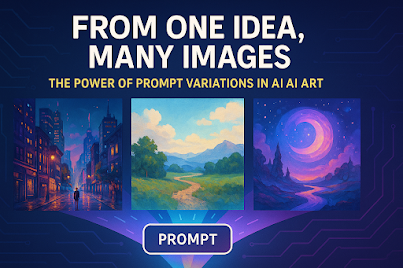In the evolving world of generative AI, the way we communicate with machines has become an art in itself. A single theme, when approached with different prompts, can produce a wide spectrum of visual outcomes—each unique in mood, detail, and narrative.
This phenomenon highlights a growing field known as prompt engineering—the craft of shaping inputs to influence AI outputs creatively and meaningfully. Whether you’re an artist, developer, or curious creator, understanding how prompt variation works is key to unlocking the full potential of AI-generated visuals.
In this blog, we explore how different prompts, all based on the same core idea, can lead to drastically different results. Each example below starts with a shared concept and evolves through creative language.
Theme/Idea : Coding Vs Vibe Coding
Prompt 1:
Landscape digital illustration for a blog post titled "Coding Vs Vibe Coding." Split the image into two contrasting scenes. On the left: a traditional coder in a dark, minimalist setup with multiple monitors, intense lines of code, a focused expression, and a serious atmosphere. On the right: a 'vibe coding' setup—relaxed programmer in comfy clothes, surrounded by ambient lighting, plants, a cup of coffee, and lo-fi music vibes. Colorful, creative, and cozy. Clean, modern, high-resolution art for a tech lifestyle blog.
Prompt 2:
Create a high-resolution, modern digital landscape illustration for a tech lifestyle blog post titled "Coding Vs Vibe Coding." Split the image into two contrasting halves to visually represent two different programming approaches.
Left Side – Traditional Coding:
Depict a serious, focused coder sitting in a dark, minimalist workspace. The environment features multiple monitors filled with dense, glowing lines of code, a mechanical keyboard, and a stark, utilitarian desk setup. The atmosphere should feel intense and immersive, with a cold color palette (blues, greys, blacks) and sharp lighting to emphasize concentration and technical complexity.
Right Side – Vibe Coding:
Contrast with a relaxed programmer lounging in a cozy, creative space. The setup should include ambient lighting, warm tones, houseplants, a cup of coffee, and a laptop with an open AI coding assistant. This scene reflects the vibe codingphilosophy—an approach that uses AI to generate code from natural language prompts. The coder's role is more about guiding, testing, and refining AI-generated code than writing it from scratch. Surroundings suggest inspiration and creativity: lo-fi music vibes, posters or wall art, soft textures, and an open, airy layout.
Overall Style:
Modern, clean, high-resolution digital art. Emphasize contrast in mood, color scheme, and energy between the two sides. Ideal for a visually compelling tech blog banner or feature image.

Prompt 3:
A landscape-oriented digital artwork with a left-to-right split scene: Left Side (Traditional Coding): A developer sitting in a dimly lit, tech-heavy workspace with multiple monitors showing black terminal windows, code syntax, and diagrams. The environment feels structured, logical, and serious—dark greys, cool blues, and sharp lines. Right Side (Vibe Coding): A relaxed, creative coder sitting cross-legged or reclining with a laptop, in a bright, aesthetically pleasing space with ambient lighting, plants, coffee, and soft visuals. Code appears like flowing art—perhaps music notes or colorful curves emanating from the screen. Colors here are warm and vibrant—purples, pinks, oranges, and neon blues. Center/Top Text (Bold and Stylish Font): "The Rise of Vibe Coding" Subtext (Smaller, Below or Top-Right): Intuition, Flow, and Freedom in Software Development Style: Slightly futuristic, creative-tech aesthetic with contrast between structure and flow.




